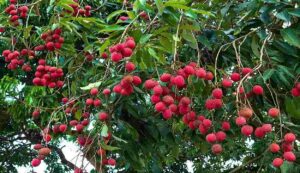Litchi Cultivation: If you want to get better yield in litchi cultivation, then keep these 9 things in mind
Litchi Cultivation: The distinctive flavor, perfume, and nutritional qualities of litchi, a tropical and subtropical fruit, have made it very popular. Litchi blooming and fruit production depend heavily on an appropriate agroclimatic environment. Climate, temperature, humidity, light, and soil conditions are the primary determinants of the blooming process. The agroclimatic conditions necessary for litchi blossoming are described here.

1. Weather and temperature requirements
For litchi to blossom successfully, the following temperature and certain meteorological conditions are necessary:
Low temperatures (12–18°C) are necessary for litchi blossoming in the winter months. This phenomenon, referred to as the “chilling effect,” gives flowers their boost.
At the time of blossoming, lychee need certain climate and temperature conditions. The blooming process may be hampered if the temperature deviates from these specifications. 15 to 22°C is the ideal temperature range for litchi blossoming. Flower development is inhibited if the lowest temperature during blooming is less than 12°C, whereas the flowering process is interrupted and the flowers begin to fall if the temperature is higher than 28°C. Fruit setting and blooming are impacted by very hot or cold temperatures.
Hot, dry weather: Following blooming, hot, dry weather promotes fruit ripening and development.
High temperature detrimental: The blossoming process may be impacted if the wintertime temperature rises over 20°C.
2. The function of air and humidity
Humidity: During the blooming season, moderate humidity (60–70%) is desirable.
Airflow: Pollination and blooming in litchi orchards are aided by adequate air movement. Strong winds or high humidity may cause flowers to tumble.
3. The need for light
Photoperiod: The duration of the day is very significant for litchi blossoming.
Lychees often blossom when the days are short.
sunshine: Litchi trees thrive in locations with plenty of sunshine. Production is impacted and blossoming is reduced in shaded places.
4. Properties of Soil
Fertile, deep soil: Litchi trees thrive in deep, sandy loam soil.
pH level: The ideal range for the soil’s pH is 5.5 to 7.0. Soils that are very alkaline or acidic might prevent flowers from blooming.
Drainage: Since waterlogging weakens roots and inhibits blooming, well-drained soil is crucial.
5. Management of irrigation and nutrients
Nutrients: Litchi trees should have a balanced supply of nitrogen, phosphate, and potash before blooming. This should happen just after the fruit is harvested.
Irrigation: Since too much moisture prevents flowers from blooming, irrigation should not be done during the two months before blossoming. In very dry conditions, very little irrigation is necessary. To keep the orchard wet, mulching should be done. Additionally, this keeps the orchard wet and inhibits the growth of weeds.
6. Location’s role
Bihar, West Bengal, Uttar Pradesh, and the northeastern parts of India are said to have climates that are ideal for growing litchi.
7. How blossoming is affected by climate change
Temperature increases and weather fluctuations might have an impact on the blossoming process. Unexpected rain or a hailstorm might cause flowers to tumble.
Microclimates, or small-scale climate management, should be established in orchards to lessen the effects of climate change.
Installing overhead sprinklers in litchi orchards is the only method to prevent the summer temperatures in North India from rising beyond 40 degrees Celsius in April. Otherwise, growing high-quality litchi is becoming very challenging.
8. Pollination and biotic factors
Pollinators and insects: During blooming, bees and other pollinators are crucial. Without them, output may decline.
Management of pests and diseases: During blooming, protection against powdery mildew and other diseases is crucial.
9. The importance of agricultural management for blooming
Flowering is enhanced when litchi trees get the necessary trimming and nutrition management prior to winter. Prior to blooming, it’s critical to regularly inspect orchards and treat pests and diseases.

